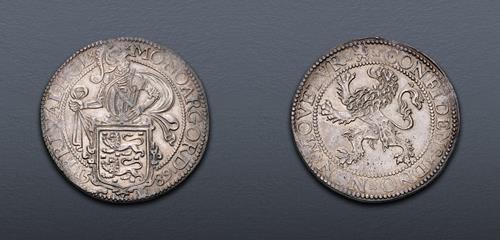
|
LOW COUNTRIES, Republic of the Seven Netherlands (Dutch Republic). Friesland. 1581-1795. AR Leeuwendaalder – Lion Daalder (41mm, 27.13 g, 8h). Dated 1589.
Triton XXV
Lot: 1201. Estimated: $ 20 000
World, Silver
Sold For $ 26 000. This amount does not include the buyer’s fee.
Go to Live
|
|
LOW COUNTRIES, Republic of the Seven Netherlands (Dutch Republic). Friesland. 1581-1795. AR Leeuwendaalder – Lion Daalder (41mm, 27.13 g, 8h). Dated 1589. Armored half-length figure of soldier standing left, head right; coat-of-arms below / Lion rampant left. P&W Fr18; CNM 2.16.32; Delmonte, Argent 849. Exceptionally well struck. Lightly toned. UNC. Extremely rare in this magnificent state of preservation, especially so from this mint.
From the J. de Wilde Collection.
Several coins were produced in the Netherlands to help facilitate export trade. Probably the most important of these coins was the lion dollar (the leeuwendaalder), which was first minted in the Dutch province of Holland in 1575 during their struggle for independence. Within a short time, lion dollars were produced by six of the seven Dutch provinces, along with independent issues produced by some of the major cities. The lion dollar circulated throughout the Middle East, the Dutch colonies, as well as in the Dutch New Netherlands Colony. The lion dollar also circulated throughout the English American colonies during the 17th and early 18th centuries, especially in Maryland, Massachusetts, New Jersey, Pennsylvania, and Virginia.
The inflow of these lion dollars into the American colonies was not only by trade, but also by piracy. Looted lion dollars from ships as far away as the African coasts are documented. Lion dollars were also called “dog dollars,” as the lion of the first examples looked more like a dog than a lion. As these coins were very popular for international trade, the dies were produced in great haste and thus are usually very crudely executed. Examples circulating in the colonies were usually fairly well worn so that the design was not that easy to recognize. The term “dog dollar” is an indication that the first types were already in use in the Dutch colony of New Amsterdam, which was founded in 1624 (and renamed to New York by the British in 1660). The name is found in colonial-era documents used to officially tariff this dollar for circulation in the American colonies.
The final winners of all Triton XXV lots will be determined at the live public sale that will be held on 11-12 January 2022. Triton XXV – Session Four – Early Medieval & Islamic Coinage through Large Lots will be held Wednesday afternoon, 12 January 2022 beginning at 2:00 PM ET.
Winning bids are subject to a 20% buyer's fee for bids placed on this website and 22.50% for all others.
We recognize that our users may have various Internet Browsers and Operating Systems. We like our visitors to have the best possible experience when using our bidding platform. However, we do recognize that it is impossible to develop applications that work identically, efficiently and effectively on all web browsers. The CNG bidding platform supports the latest stable major version and the stable previous version of Mozilla Firefox and Chrome.
|
